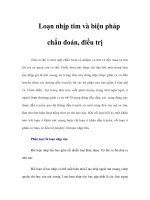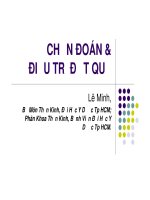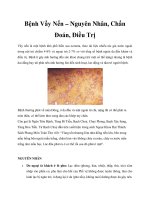Chẩn đoán điều trị thiếu máu thiếu sắt trẻ em 2019
Bạn đang xem bản rút gọn của tài liệu. Xem và tải ngay bản đầy đủ của tài liệu tại đây (1.03 MB, 44 trang )
CHẨN ĐOÁN VÀ ĐIỀU TRỊ
THIẾU MÁU THIẾU SẮT
Hội nghị Khoa học Nhi khoa Bệnh viện Nhi Đồng 1
TPHCM, 20-21/9/2019
TS BS Nguyễn Minh Tuấn
Bệnh viện Nhi Đồng 1
Khoa Y – Đại học Quốc gia TPHCM
Đơn vị Nghiên cứu Lâm sàng Đại học Oxford
Contents
•
•
•
•
•
•
Definition of iron deficiency anemia
Epidemiology
Iron metabolism
Etiology
Diagnosis
Management
Contents
•
•
•
•
•
•
Definition of iron deficiency anemia
Epidemiology
Iron metabolism
Etiology
Diagnosis
Management
ANEMIA
Defined as an insufficient RBC mass to adequately
deliver oxygen to peripheral tissues.
-- Wintrobes
Defined as a decrease in the amount of red blood cells
(RBCs) or the amount of hemoglobin in the blood. It
can also be defined as a lowered ability of the blood to
carry oxygen.
-- Wikipedia
Anemia is defined as a reduction of the total circulating
red cell mass below normal limits
-- Robbins
ANEMIA
Theo Tổ chức Y tế thế giới, gọi là thiếu máu khi lượng
hemoglobin (Hb) dưới giới hạn sau đây:
Hb bình thường
Thiếu máu
Trẻ sơ sinh (đủ tháng)
(g/dL)
13.5 – 18.5
(Hb ≤ giới hạn)
13.5 (Hct 34%)
Trẻ từ 2 – 6 tháng
9.5 – 13.5
9.5 (Hct 28%)
Trẻ từ 6 tháng đến 2 tuổi
10.5-13.5
10.5 (Hct 33%)
Trẻ từ 2 – 6 tuổi
11.0 – 14.4
11.0 (Hct 33%)
Trẻ từ 6 – 12 tuổi
11.5 – 15.5
11.5 (Hct 34%)
Nam trưởng thành
13.0 – 17.0
13.0 (Hct 39%)
Nữ trưởng thành (không mang
thai)
12.0 – 15.0
12.0 (Hct 36%)
Tuổi / giới tính
IRON DEFICIENCY ANEMIA
Anemia with biochemical evidence of iron
deficiency based on following laboratory findings:
• serum ferritin,
• total iron binding capacity (TIBC),
• transferrin saturation,
• or transferrin receptor
Contents
•
•
•
•
•
•
Definition of iron deficiency anemia
Epidemiology
Iron metabolism
Etiology
Diagnosis
Management
EPIDEMIOLOGY
• Globally, anemia affects 1.62 billion people ,
which corresponds to 24.8% of the population
• IDA occurs across all populations and is
associated with
✓ Diminished QOL
✓ Physical and cognitive performance, and
✓ Unfavorable clinical outcomes
Classification of anemia as a problem
of public health significant
Anemia prevalence
Contents
•
•
•
•
•
•
Definition of iron deficiency anemia
Epidemiology
Iron metabolism
Etiology
Diagnosis
Management
IRON DISTRIBUTION
IRON DISTRIBUTION
• Most body iron is present in haemoglobin in
circulating red cells
• The macrophages of the reticuloendotelial
system store iron released from haemoglobin
as ferritin and hemosiderin
• Small loss of iron each day in urine, faeces,
skin and nails and in menstruating females as
blood (1-2 mg daily)
IRON ABSORPTION
IRON ABSORPTION
• Food sources supply: 10 - 25 mg / day
• Absorbed in the brush border of the upper small
intestine
– Enhanced by gastric acid
– Inhibited by tannins, systemic inflammation
• Most dietary iron is nonheme form, <5%
bioavailability
• < 10% dietary iron is heme form, >25%
bioavailability
Iron absorption from food
Rice
Spinach
Black beans
Corn
Lettuce
Wheat
Soy beans
Ferritin
Veal liver
Fish muscle
Hemoglobin
Veal muscle
Non-heme
iron
Heme
iron
0
5
10
15
20
Iron Absorption (% of dose)
25
Contents
•
•
•
•
•
•
Definition of iron deficiency anemia
Epidemiology
Iron metabolism
Etiology
Diagnosis
Management
ETIOLOGY
• IDA results from prolonged negative iron balance
• Mainly due to following factors:
1. Inadequate iron intake: infancy, inappropriate diet
2. Decreased iron absorption:
3. Increased iron demand or hematopoiesis:
prematurity, low-birth weight, cyanotic congenital
heart diseases, polycythemia
4. Increased iron loss: GI bleeding, menorrhagia,
recurrent bleeding of hematologic diseases, etc.
Matthew W. et al. Am Fam Physician. 2013;87(2):98-104
PROGNOSIS
IDA adversely effects:
• Cognitive performance, behavior, and physical
growth of infants, preschool, and school-aged
children
• The immune status and morbidity from infections
of all age groups
• The use of energy sources by muscle and thus the
physical capacity and work performance of
adolescents and adults of all age groups
• Increase perinatal risks for mothers and neonates
and overall infant mortality during pregnancy
Contents
•
•
•
•
•
•
Definition of iron deficiency anemia
Epidemiology
Iron metabolism
Etiology
Diagnosis
Management
Preliminary findings
Chief Complaints
Fatigue, lassitude, palpitation, and
generalized weakness
History
Chronic blood loss, deficient diet
Clinical Features
1. Palor: skin, nailbed, conjunctiva
2. Koilonychia (brittle, spoon shaped nails)
3. Atrophic glossitis (atrophy of tongue papilla;
making the tongue smooth and shiny)
4. Pica (compulsive eating of nonfood items)
or pagophagia (compulsive eating of ice)
Symptoms and Signs
Symptoms
Decreased exercise
tolerance
Fatigue
Dizziness
Irritability
Weakness
Palpitations
Vertigo
Shortness of breath
Chest pain
Signs
Tachycardia
Pale appearance (most
prominent in
conjunctiva)
Decreased mental acuity
Increased intensity of some
cardiac valvular murmurs
Laboratory evaluation
• Complete blood count (CBC), erythrocyte
sedimentation rate (ESR), and peripheral
blood film (PBF)
• Serum Iron profile
• Bone marrow study (if needed)
• Investigations to determine other causes of
IDA (e.g. fecal occult blood test, colonoscopy,
gastroscopy, etc.)
Lưu đồ chẩn đoán thiếu máu









